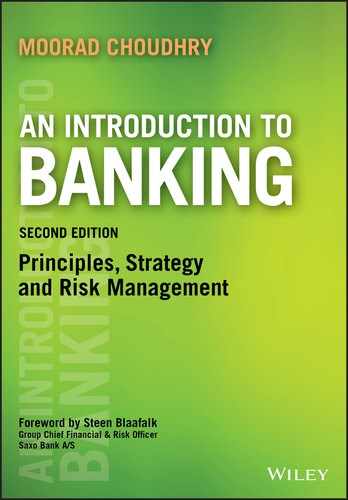FOREWORD
Steen Blaafalk
I know Moorad Choudhry as an experienced professional and very strong personally, and it is with great pleasure that I accept to write a short foreword for the new edition of An Introduction to Banking.
A key role for a bank is to transform short‐term deposits from businesses and households into long‐term loans to businesses and households that want to borrow for investments or consumption. In this way, banks support growth and wealth in society – not only by creating jobs in the banking sector – but also by supporting growth in many sectors of the economy.
An integral part of banking is taking calculated risks. A professionally run bank will reserve enough capital to absorb expected as well as unexpected losses on the lending book to continue its business, even in a recession.
Another risk is maturity transformation – borrowing short and lending long. On the one hand, it is a source of income for the bank. On the other hand, it is a threat to the survival of the bank if it is funding itself too short or through unstable funding sources that disappear when a crisis occurs.
In the years leading up to the 2008 global financial crisis, banks had become significantly less consolidated as the capital rules allowed them to have a very high gearing of the balance sheet. Moreover, many banks had funded themselves very short in the capital markets since liquidity was ample and spreads were very low – building up huge customer funding gaps. At the same time, the banks had competed fearlessly on margins in order to attract new business. A cocktail that would be doomed to go wrong at some point in time.
When the global financial crisis culminated in September 2008 with the collapse of Lehman Brothers, all confidence in and among financial institutions disappeared. This resulted in liquidity drying out very fast, and institutions with a short/unstable funding profile found themselves unable to refinance their debt. Additionally to this, many banks found themselves too thinly capitalised to absorb the loss incurring during this next period.
The global financial crisis spilled over into the real economy since many banks were not able to fund the loan demand of their customers and they did not have the excess capital to grow their balance sheets. The authorities reacted to the situation by demanding significantly higher capital and liquidity ratios, which of course in the situation catalysed the crisis in the real economy.
An Introduction to Banking describes getting the right balance between running a safe bank and optimising the use of capital and liquidity to the benefit of the shareholders of the bank for the long run.
In the first part of the book, Moorad introduces the reader to the basic concepts of running a bank. I can recommend this part of the book to bankers who need a broader insight into the institutional setup and basic terms in banking. Understanding the basics of banking helps you to get the full benefit when it becomes more detailed, dealing with asset and liability management (ALM) as well as capital and liquidity management later in the book.
Asset & Liability Management is the very essence of banking. To be successful as a bank you need to have professional asset and liability management processes, starting from the top management and flowing down to the different business areas of the bank, including proper Funds Transfer Pricing (FTP) for capital and liquidity, to understand and make transparent the drivers for various banking products.
As a Group Chief Financial and Risk Officer, I have had great professional benefit from the description of the role of the Asset & Liability Committee, the risk policy, reporting, and stress testing, as well as the description of the day‐to‐day management in the risk and treasury departments. It was also rewarding for me to read the final chapters about best practice in capital and funding management and corporate governance, which we should not forget when we enter into the next period of bull markets.
Moorad manages to describe a comprehensive and complex area of banking in a lively and readable language.
I can highly recommend the book as a handy reference work for anyone who is involved in banking strategy, ALM, and liquidity risk management.
Steen Blaafalk
Group Chief Financial and Risk Officer
Saxo Bank A/S
Copenhagen
10 March 2015
